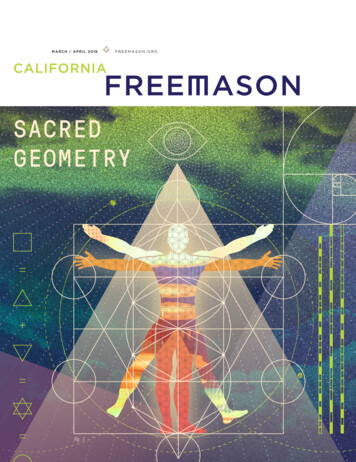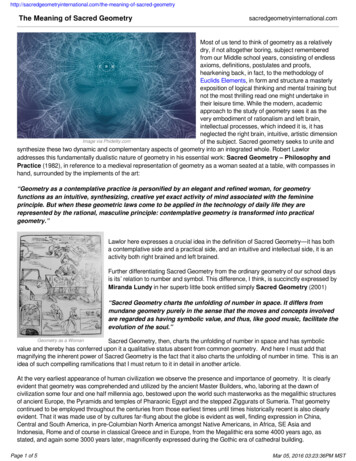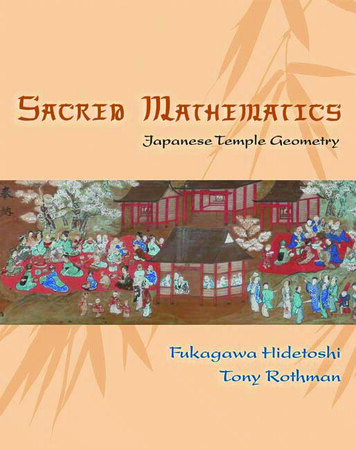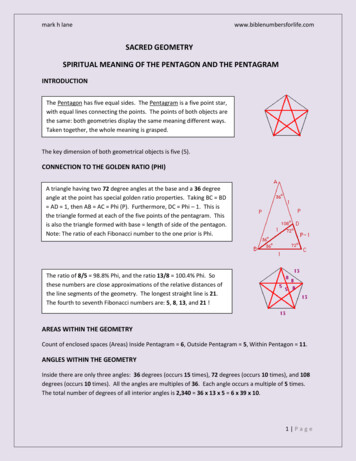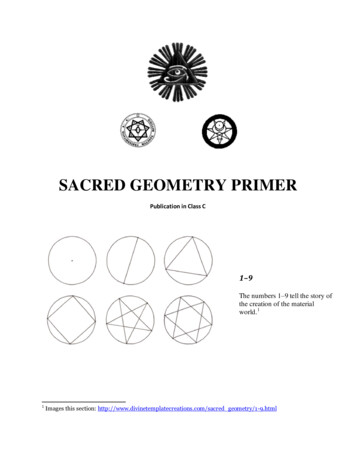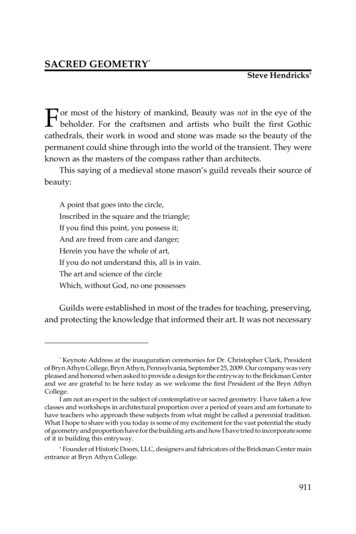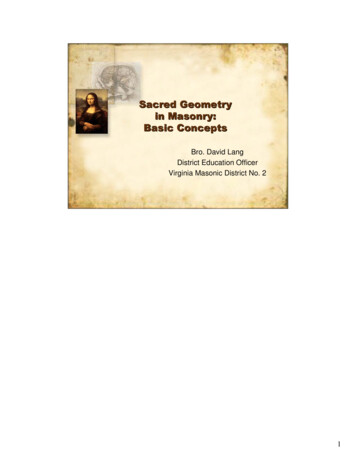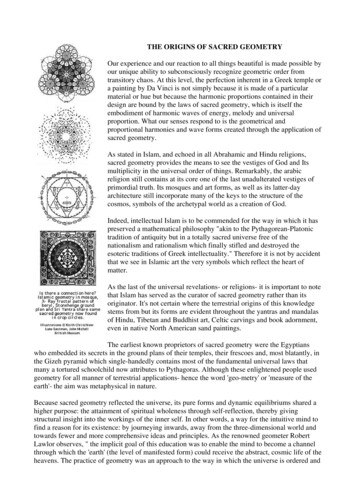
Transcription
THE ORIGINS OF SACRED GEOMETRYOur experience and our reaction to all things beautiful is made possible byour unique ability to subconsciously recognize geometric order fromtransitory chaos. At this level, the perfection inherent in a Greek temple ora painting by Da Vinci is not simply because it is made of a particularmaterial or hue but because the harmonic proportions contained in theirdesign are bound by the laws of sacred geometry, which is itself theembodiment of harmonic waves of energy, melody and universalproportion. What our senses respond to is the geometrical andproportional harmonies and wave forms created through the application ofsacred geometry.As stated in Islam, and echoed in all Abrahamic and Hindu religions,sacred geometry provides the means to see the vestiges of God and Itsmultiplicity in the universal order of things. Remarkably, the arabicreligion still contains at its core one of the last unadulterated vestiges ofprimordial truth. Its mosques and art forms, as well as its latter-dayarchitecture still incorporate many of the keys to the structure of thecosmos, symbols of the archetypal world as a creation of God.Indeed, intellectual Islam is to be commended for the way in which it haspreserved a mathematical philosophy "akin to the Pythagorean-Platonictradition of antiquity but in a totally sacred universe free of thenationalism and rationalism which finally stifled and destroyed theesoteric traditions of Greek intellectuality." Therefore it is not by accidentthat we see in Islamic art the very symbols which reflect the heart ofmatter.As the last of the universal revelations- or religions- it is important to notethat Islam has served as the curator of sacred geometry rather than itsoriginator. It's not certain where the terrestrial origins of this knowledgestems from but its forms are evident throughout the yantras and mandalasof Hindu, Tibetan and Buddhist art, Celtic carvings and book adornment,even in native North American sand paintings.The earliest known proprietors of sacred geometry were the Egyptianswho embedded its secrets in the ground plans of their temples, their frescoes and, most blatantly, inthe Gizeh pyramid which single-handedly contains most of the fundamental universal laws thatmany a tortured schoolchild now attributes to Pythagoras. Although these enlightened people usedgeometry for all manner of terrestrial applications- hence the word 'geo-metry' or 'measure of theearth'- the aim was metaphysical in nature.Because sacred geometry reflected the universe, its pure forms and dynamic equilibriums shared ahigher purpose: the attainment of spiritual wholeness through self-reflection, thereby givingstructural insight into the workings of the inner self. In other words, a way for the intuitive mind tofind a reason for its existence: by journeying inwards, away from the three-dimensional world andtowards fewer and more comprehensive ideas and principles. As the renowned geometer RobertLawlor observes, " the implicit goal of this education was to enable the mind to become a channelthrough which the 'earth' (the level of manifested form) could receive the abstract, cosmic life of theheavens. The practice of geometry was an approach to the way in which the universe is ordered and
sustained. Geometric diagrams can be contemplated as still moments revealing a continuous,timeless, universal action generally hidden from our sensory perception. Thus a seemingly commonmathematical activity can become a discipline for intellectual and spiritual insight."As a mirror of the heavens sacred geometry was liberally applied across the Egyptian landscape formillennia as a way to bestow universal order on Earth, as reflected in their Hermetic maxim 'AsAbove, So Below'.Consequently the practice of maintaining concrete records of this knowledge for posterity wasreenacted throughout Europe in fabulous structures such as Chartres cathedral, one of the mostimpressive hymns to sacred geometry, and whose dissection alone has filled entire books.That this knowledge made its way as far north as the British Isles can be clearly seen in the groundplans and blueprints of megalithic monuments, mediaeval cathedrals, and the plethora of stonecircles. It is clear, therefore, that whatever lies behind sacred geometry was important enough forscholars to go to enormous lengths to preserve it for future generations.With the advent of X-ray photography science has discoveredthat the physical structure of elements are governed by apatterned array of intervals surrounding a central node. Thegeneral assumption that the nature of matter is fundamentallycomposed of particles is rapidly giving way to the concept thatthe underlying patterns of the material world are geometric waveforms. The irony here is that by choosing to examine realitythrough geometry many ancient cultures find themselves close tothe stance now adopted by modern science, and vice versa.Little wonder, then, that sacred geometry was so important to thetemple builders. And since the universe was created by God ittheoretically followed that to embed physical structures with the ratios of creation the universecould be mirrored. In so doing, temples became doorways into the inner workings of the physicalworld and the inner world of consciousness. This interface would enable anyone so predisposed tointegrate oneself with the gods.Sadly, as these temples have fallen by the wayside so too has our wonder of the unseen and ourconnection to it, presumably why the very fabric of our present society lies rudderless and bankrupt.There are several major events which have led us to this sad reversal of thought. As Robert Lawlorunderstands it, "modern thought has difficult access to the concept of the archetypal because
European languages require that verbs or action words be associated with nouns. We therefore haveno linguistic forms with which to imagine a process or activity that has no material carrier"The Renaissance saw the last great works based on sacred geometry which had been kept alive viaPlato,and philosophies that survived suppression by the emerging Catholic Church. With theimplementation of the Inquisition, the rise in secularism and a general move toward a rational andanalytical view of the world, connections to holistic and metaphysical practices were severed. Bythe time Newton and the scientific secularism of the 17th century prevailed rational logic hadgained such a dominance that all esoteric knowledge was inevitably condemned as occult (literalmeaning, 'that which is hidden').CONNECTING SACRED GEOMETRY AND CROP CIRCLESIt is significant that as our alienation from all forms of spiritual and universal wonder increases,symbols bearing the hallmarks of an ancient, harmoniousphilosophy have suddenly begun manifesting in cereal crop.Even to the hardened skeptic crop circle designs reveal afacility by their makers of creating a visual harmony that ispleasing to the eye, much like an ancient temple or aclassical painting. The proportions are balanced, the shapesrhythmic, their outlying elements forming part of an unseenwhole. Upon close scrutiny even the small 'grapeshot' circlesthat flank certain formations lie at their given remotelocations not by fluke but by engineered and premeditateddesign, markers and clues for the observer to follow anduncover. Not surprising, then, to find sacred geometry lyingat the heart of the fundamental blueprints of manyformations, sometimes blatantly, sometimes veiled like asecret waiting to be uncovered only by the most persistent of
minds.But just as with sacred geometry and other esoteric principles, crop circles have been marginalizedby practically the entire scientific community since they challenge the current worldview simplybecause science is at odds to explain them.According to science, crop circles don't exist.Yet, as these examples demonstrate, crop circles, through their complicated geometric structure, areworthy of being ranked alongside the greatest creations of mankind. Perhaps even higher.When analyzing crop circle forms through the precise and unalterable practice of sacred geometryone cannot help but appreciate that a mind of scholarly intelligence is involved, just as the greatmasters of Islamic and Egyptian art, as Keith Critchlow remarked, "were motivated by and versedin spiritual disciplines that gave content and meaning to their work and placed it in the tradition ofaiding the viewer to raising his or her spiritual understanding."That these symbols are occurring primarily in wheat, the very symbol of the Earth Mother, issignificant in itself. Perhaps they are here to draw us as a race together by this interaction with oursymbol of life? Maybe their geometric symbolism acts as a mandala which like its Buddhistcounterpart contains the very vibrations that aid one in achieving inner transformation at this mostvulnerable moment in our history?If neither of these apply then what we have strewn in fields across the world is nothing more thanthe highest form of cosmic art. Perhaps all of the above are true, and perhaps other explanationsremain elusive. But one thing is certain- it is a lot of trouble for a bunch of individuals to go to,turning out during every night of the English summer for a quarter of a century, wading throughmuddy fields, and working with a brittle and imprecise canvas just to show the world they simplyremained conscious throughout geometry lessons!
In the selected range of crop circle designs we see recurring themes that are for the most partgenerated from within a circular form and continue, through proportional expansion, to developwell beyond the boundaries of the design. This is consistent with the principle of sacred geometrywhere the circle is the principal element since it lies at the heart of the creative principle. It's therepresentation of cosmic life, from the smallest atom to the largest planet. All things are dividedfrom within itself so, paradoxically, all things are contained within it. It is therefore the symbol ofthe unknowable, of spirit and of heaven.The symbolic opposite of the circle is the square which is considered material and of the earth. Bothforms, when given equal areas and superimposed, become a symbol of the fusion between humanityand the universe, of spirit and matter. It is the first symbol and the one on whose proportions wholecosmological cities were foundedThe division of the circle into two equal size circles, with the centers of their respectivecircumferences touching each other, gives birth to an overlapping figure of profound symbolism:the vesica piscis. It is from within its vagina-like center that the symbols of sacred geometry areborn.From the vesica we can create the simplest of polygons, the equilateral triangle. The two trianglescontained in this 'womb' are themselves symbolic of the world above and the world below, just asthe left circle can represent spirit and the right one matter. It is symbolic to Christianity asrepresentational of Jesus Christ and the Piscean age; as the Holy of Holies it carries the number2368 in gematria, the number also equated with Jesus Christ.
The overlapping of both triangles produces the hexagon, also referred to as the Star of David. Thecharacteristics and symbolism behind this figure are immense. It is also through the natural divisionof a circle into six parts which allows six circles to fit exactly around the circumference of an equalseventh. John Michell has studied the implications of the hexagon at length and further adds that itis "symbolic of the order of the universe in the fact that twelve equal spheres can be placed around athirteenth so that each touches the nucleus and four of its neighbors, producing the geometer'simage of twelve disciples grouped around the master. Christ, Osiris and Mohammed are amongthose who are represented as a central sphere with twelve retainers." It is also a common symbol inIslamic geometry, and its qualities are rational and solar, as evidenced by its 6x60-degree triangleswhich reflect the solar number 666.Another symbol of great fascination to ancient and moderngeometers is the golden mean since it gives rise to a spiral formwhich occurs in many natural forms and patterns of plant growthwhich, as Michell points out, "gives support to the tenet oftraditional philosophy that number preceded creation anddetermined its development."It is from the golden mean that we also extrapolate the pentagonand the five-pointed star, and with it the association withhumanity since the human figure with outstretched limbs issimilar to the pentagram. This was the symbol of thePythagorean's humanistic science and consequently worn as atalisman of good health. Its symbolism frequently pervadesnative American philosophy, just as Christians associated thepentagram with Jesus. The pentagon is lunar and psychic; theangle between two sides of a pentagon is 108 degrees, 1080being the characteristic lunar number.These primary geometric forms, along with their 3-dimensional counterparts, the Platonic solids,were thus observed by many ancient cultures to be the crystallizations of the creative thoughts ofGod as they emerge from the circular Unity. As a metaphor of universal order, sacred geometry ispervasive in imagery throughout history, from circular mandalas to sacred temples. And now, cropcircles.CONCLUSIONIt is interesting that today we find ourselves at the final crossroads in our evolution. Since that daywhen we decided to abandon our faith in the universal way and follow the mechanical codes ofscience our consciousness has shifted from one of reverence for all things sacred to the worship ofabstract materialism. Consequently, our change of attitude has endangered our living, breathingcelestial sphere and it's perhaps why crop circles, with their foundations based squarely upon sacredgeometry, have chosen to appear at this particular point in time, reminding us that if only weobserve the fundamental laws of the universe we may still be in time to discover the secrets ofuniversal harmony and salvage our very own symbol of eternal life, the Earth.If an artificial or electromagnetic energy source is interacting with the natural cycle of plants, it is perfectlynatural to assume the effect is verifiable at the microscopic level.
In 1988 Andrews and Delgado sent plant samples from crop circles, together withcontrols, to Signalysis laboratory in Stroud, England. The samples wereprocessed by Kenneth and Rosemary Spelman in accordance with a procedureapproved in the German Government's "Pharmacopoeia for Homeopathy" forspagyric preparations- a process normally used in the diagnosis of human bloodsamples. The method allows for the crystalline structure of fluid to be examinedunder a microscope.Their results revealed how the irregular pattern in control samples had taken on astrict structuring pattern inside crop circles - energy of some type had changed theplants' crystalline structure. A separate barrage of tests on samples from a cropcircle in Argonne, Illinois, by molecular biologist Kevin Folta, even showed that theplant DNA was considerably more degraded than the controls.After the Spelmans' tantalizing report was published, Pat Delgado was contactedby another interested party, this time from Michigan, hoping to follow up on whatthe initial UK experiments had started.Dr. W. C. Levengood is a respected biophysicist. Over the course of hismulti-disciplinary career he has conducted investigations into suchareas as the effects of solar and cosmic rays on the reproduction ofliving organisms, and the relationship between ion transport and vigourselection in seeds. In addition to his worldwide reputation he holds sixpatents and has written fifty peer-reviewed papers.Levengood's curiosity led him to investigate the possibility of molecularchanges in crop circle plants. After thousands of hours of field work andlaboratory studies on hundreds of crop circles, as well as controlledman-made scientific experiments and tests on control samples, a seriesof statistically significant anomalies were detected.One of the first puzzles Levengood came across concerned the seeds.Seed heads collected from the 1991 Barbury Castle formation appearednormal, until they were compared to control samples and found to beconsiderably stunted. Contrary to nature, they were also totally devoidof seeds. Yet control samples taken at various distances away from theformation contained seeds as normal. But true to crop circle fashion thiswas not to be the rule: in other cases where the seeds were present,they were often severely stunted, malformed, lower in weight and/orreduced in size. Levengood attributed this to a premature dehydration ofthe seeds, their development arrested at the time the crop circle wascreated.The critical time for alterations appears to occur early on in the seed'sdevelopment, the effect becoming less visible relative to the seeds'maturity; when mature, an increase in seed growth occurs.To see how the seeds reacted when germinated, closely-monitored 14day laboratory trials were conducted to compare their growth cycle withcontrols. Levengood noted that the crop circle seeds reacted variably, depending upon the intensity of thecrop circle energy as well as the age of the plants when affected.The results show an inconsistency with natural plant development: in some of the immature plants the seedsfailed to germinate; in young plants they did germinate but with grossly depressed development in roots andshoots; plants affected in the late life-cycle by crop circle energy developed in a manner inconsistent withseeds of that species, revealing accelerated germination and increased vigour in the more mature plants, thelatter exhibiting a growth rate 40% faster than normal, with a healthier root structure to boot.
But what kind of energy was capable of altering the plants' naturalcycle? To find out, Levengood tested a sample of plants in acommercial microwave oven. The results revealed that the closestsimilarities to crop circle samples- even at the microscopic leveloccurred when the plants were subjected to 30 seconds of microwave,not a far cry from the range described by eyewitnesses; evidence of thisrapid heating was corroborated by a superficial charring of the planttissue which left deeper layers unaffected, thereby indicating the brevityof the action.In his first peer-reviewed paper on crop circles, Anatomical Anomaliesin Crop Formation Plants , Dr. Levengood states that "the affectedplants have components which suggest the involvement of rapid airmovement, ionization, electric fields and transient high temperaturescombined with an oxidizing atmosphere. One naturally occurring andorganized force incorporating each of these features is an ion plasmavortex, one very high energy example being a lightning charge."Another conundrum revolved around the plant's nodes. These fibrousprotuberances are the hardest portions of the stem, allowing a plant tosupport its weight and maintain its upright posture. Levengood foundthe nodes in crop circle plants grossly enlarged and expanded, muchmore than could be accounted for by trauma, exposure to chemicals orinfestation. And although both phototropism and gravitropism both playa role in the bending of nodes, these natural processes take time todevelop and do not account for the massive node bending observed innew crop circles; incidentally, slight node length extensions in manmade formations proved statistically insignificant.But by far the most important discovery in his research centres aroundthe nodes' bract tissue- the thin membrane supporting the seed headthat enables nutrients to be supplied to the developing embryo. WhatLevengood found here was an abnormal enlargement of the tissues' cellwall pits- the minuscule holes that allow the movement of nutrients.Here, a series of expulsion cavities, or 'blow holes', were discovered, asif internal liquid had been forced out from inside the plants. Again, this is not found in normal crop under anycircumstances.In a dramatic comparison to the control samples, the elongated scars clearly show how a rapid expansionhas taken place inside crop circle plants, a result of the water in the cell walls being suddenly heated. Withnowhere to escape, the water forces its way out by exploiting the weaker sections of the tissue therebycreating the scars.Levengood concluded that "the energy mechanism producing quantitative alterations in the plant stem nodesfalls within the framework of a straight-forward and widely applied principal of physics [Beer's Law] dealingwith the absorption of electromagnetic energy by matter," strongly suggesting that an energy source"originating in the microwave region" had boiled the water inside the plants' nodes, effectively transforming itinto steam.Michael Chorost reached similar conclusions in his published report for Project Argus: the phenomenoninduces radiation anomalies, heats plants rapidly and briefly through a rapid pulse of unknown energy,sometimes scorching them; it swells their cell wall pits and interacts with the development of the seeds, andleaves radioactive traces in the soil.One experiment carried out in June 1995 put Levengood's research to the test. Without knowledge of itscreators, Levengood's team took home samples from a crop circle which had been deliberately man made.Yet despite the usual tests, no discrepancies were found between the formation' samples and the controls.
X-RAY DIFFRACTION STUDY OF CANADIAN CROP CIRCLEAfter constant delays (mostly due to financial constraints) the X-ray diffraction study of clay minerals in cropcircle soils, which was begun in 1999 and completed in late 2001, is now available on the BLT ResearchTeam Inc.'s web-site at: http:://www.bltresearch.com/xrd.html. BLT is most grateful to Mr. and Mrs. Lyman D.Rogers of Newtown, Connecticut, whose financial support made this possible, and to web-site personnel KimMcDonald Gazecki, William Bombardier, and Abby Lewis who did the actual work of transferring the study tothe web.This study, funded by Laurance Rockefeller, examined specific clay minerals (those which are called"expandable" clays and which are most sensitive to heat) in crop circle soils, in an attempt to gather furtherdata which might inform us regarding the hypothesized presence of microwave radiation at crop circle sites.Multiple scientists were involved (see "Study Personnel"), most of whom were totally unacquainted with thecrop circle phenomenon at the time they carried out their individual work on the project. These scientistswere carefully chosen, not only for their specific expertise, but because they were unaware of thephenomenon, thus ruling out any potential assertions by skeptics of "experimenter bias."The results are startling. Specific clay minerals (illite/smectites) are shown to exhibit a subtle, but statisticallysignificant, increase in degree of crystallization.a change heretofore seen only in sedimentary rock, whichhas been exposed to the massive pressure (called "geologic" pressure) of tons of overlying rock and to heatfrom the earth's core over hundreds, or thousands of years. To our knowledge this increase in degree ofcrystallization has never been reported previously in surface soils (as is the case here).If "geologic" pressure had been present, obviously the plants would have been obliterated. And, of course,they were not. Further, if the intense heat required (a minimum of 6-800 degrees C, over a period of manyhours) to produce the crystalline change (in the absence of such geologic pressure) had been present, theplants would have been incinerated. And, again, they were not. The plants did show the well-documentedchanges (elongated apical nodes, presence of expulsion cavities) regularly found in crop circles which arenot created by mechanical flattening (i.e., with planks and boards). What is MOST interesting is the fact thatboth the documented plant changes and the increases in clay-mineral crystallization occurred at the SAMEsampling locations. A regression analysis found that the node-length increases in the plants were correlatedwith the increase in crystallization of the clay minerals in the soils at the 99.2% level of confidence, a trulyextraordinary result.So the data appear to indicate that whatever caused the plant changes, also caused the soil changes at thesame sampling locations. And yet we realize that the intense energy situation required to produce the soileffects would have destroyed the plants altogether. As Dr. Reynolds, the Dartmouth mineralogist andrecognized authority on clay minerals and the XRD technique whom we asked to review our study stated, weare apparently dealing with an energy currently unknown to science.As is often the case in science, new and intriguing questions have been raised. The notion of mechanicalflattening, however, is without question ruled out.We hope that all interested members of the crop circle community will take the time to examine the newstudy. All of the data and personnel involved have been included on the web-site. BLT welcomes commentsand/or questions. Please note, also, that many other changes and additions have been made to other pageson the site, including the following pages: "Home," "Plant Abnormalities," "Clay-Mineral XRD Study," "OtherFacts," "Professional Consultants," "Lab Reports," and "Contact."by Nancy TalbottBLT Research Team Inc. http://www.bltresearch.com
The long-awaited XRD study focusing on the seven-circle barley formation at Edmonton, Alberta in 1999 isnow available at http://www.bltresearch.com/xrd.htmlOrigin of Crop Circles Baffles Scientistsby Leslie Keanfrom THE PROVIDENCE JOURNAL, San Francisco, 16 September 2002SINCE THE RECENT release of the movie Signs, crop circles have been thrust into the limelight. Suchmajor publications as Scientific American and U.S. News and World Report have echoed the common beliefthat all crop circles are made by stealthy humans flattening plants with boards. This assumption would be fairenough if we had no information suggesting otherwise.However, intriguing data published in peer-reviewed scientific journals clearly establishes that some of thesegeometric designs, found in dozens of countries, are not made by "pranks with planks." In fact, a study aboutto be published by a team of scientists and funded by Laurance Rockefeller concludes "it is possible that weare observing the effects of a new or as yet undiscovered energy source."In the early 1990s, biophysicist William C. Levengood, of the Pinelandia Biophysical Laboratory, in Michigan,examined plants and soils from 250 crop formations, randomly selected from seven countries. Samples andcontrols were provided by the Massachusetts-based BLT Research Team, directed by Nancy Talbott.Levengood, who has published over 50 papers in scientific journals, documented numerous changes in theplants from the formations. Most dramatic were grossly elongated plant nodes (the "knuckles" along thestem) and "expulsion cavities" -- holes literally blown open at the nodes -- caused by the heating of internalmoisture from exposure to intense bursts of radiation. The steam inside the stems escaped by eitherstretching the nodes or, in less elastic tissue, exploding out like a potato bursting open in a microwave oven.Seeds taken from the plants and germinated in the lab showed significant alterations in growth, as comparedwith controls. Effects varied from an inability to develop seeds to a massive increase in growth rate -depending on the species, the age of the plants when the circle was created and the intensity of the energysystem involved.These anomalies were also found in tufts of standing plants inside crop circles -- clearly not a result ofmechanical flattening -- and in patches of randomly downed crops found near the geometric designs. Thesefacts suggested some kind of natural, but unknown, force at work.Published in Physiologia Plantarum (1994), the international journal of the European Societies of PlantPhysiology, Levengood's data showed that "plants from crop circles display anatomical alterations whichcannot be explained by assuming the formations are hoaxes." He defined a "genuine" formation as one"produced by external energy forces independent of human influence."A strange brown "glaze" covering plants within a British formation was the subject of Levengood and John A.Burke's 1995 paper in the Journal of Scientific Exploration. The material was a pure iron that had beenembedded in the plants while the iron was still molten. Tiny iron spheres were also found in the soil.In 1999, British investigator Ronald Ashby examined the glaze through optical and scanning electronmicroscopes. He determined that intense heat had been involved -- iron melts at about 2,700 degreesFahrenheit -- administered in millisecond bursts. "After exhaustive inquiry, there is no mundane explanationfor the glaze" he concluded.In another paper for Physiologia Plantarum (1999), Levengood and Talbott suggested that the energycausing crop circles could be an atmospheric plasma vortex -- multiple interacting electrified air masses thatemit microwaves as they spiral around the earth's magnetic-field lines.
Some formations, however, contain cubes and straight lines. Astrophysicist Bernard Haisch, of the CaliforniaInstitute for Physics and Astrophysics, says that such "highly organized, intelligent patterns are notsomething that could be created by a force of nature."But Haisch points out that since not all formations are tested, it is unknown how many are genuine. Nor is itlikely that such complex designs could evolve so quickly in nature. "Natural phenomena make mountainranges and form continents -- they don't learn geometry in ten years," says Haisch, who is the science editorfor the Astrophysical Journal.In 1999, philanthropist Laurance Rockefeller made possible the most
sacred geometry. As stated in Islam, and echoed in all Abrahamic and Hindu religions, sacred geometry provides the means to see the vestiges of God and Its multiplicity in the universal order of things. Remarkably, the arabic religion still contains at its core one of the last unadulterated vestiges of primordial truth.
